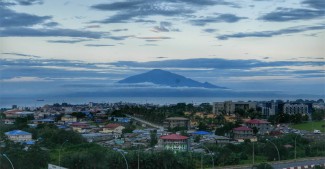|
|
|
The international system governing the environment and economy is under pressure. Globalisation itself is wobbling, to the chagrin of governments in rich and emerging economies. What's less talked about is the effect on the world's 47 least developed countries (LDCs), home to a billion people, a quarter of whom live in extreme poverty.
The financial system has long been rusty. Criticism was again this year levelled at the selection process for the heads of the World Bank and International Monetary Fund (IMF). Developing country voices called for an open and transparent process based on a pool of candidates drawn from all countries, rather than only from the United States and Europe. Leadership by the world's marginalised nations would give them voice, re-orientating the World Bank and IMF towards their own needs.
Donors are not as generous as they used to be – with worse to come after it recently emerged the United States might chop US$4 billion from its aid budget. Development aid to LDCs has stagnated in recent years as some rich countries reallocate or cut aid. The latest figures show that support from official donors to all countries fell to US$146.6 billion in 2017 as donors spent less on in-country refugee costs. Only five out of 30 countries from the Organisation for Economic Co-operation and Development (OECD) Development Assistance Committee currently meet their pledges on aid, down from a peak of six.
Recent moves to redefine and repackage development assistance as a joint public-private endeavour have been criticised in some quarters as attempts by official government donors to escape their obligations. The private money mobilised in LDCs is only a third of the global average. Only 8% of blended finance goes to LDCs, with most going to middle-income countries. Of the US$52 billion directly mobilised by multilateral development banks in long-term private co-financing during 2017, only US$2 billion went to LDCs and other low-income countries.
Rich countries are not doing as much about environmental breakdown as they should. Support for the Paris Climate Change Agreement has been thrown into doubt despite progress on the work programme over the last couple of years. Any failure to meet targets will have the biggest impact on developing countries and LDCs. Promised adaptation and mitigation funding has often not materialised. LDCs at risk of extreme weather or with a large number of people living in low-lying islands or coastal zones – like Bangladesh and the Pacific islands – are under particular threat. Those countries cannot afford to protect their people from climate breakdown like the rich world can.
Only 8% of blended finance goes to LDCs, with most going to middle-income countries.
LDCs are increasingly unequal, as the urban nouveau riche leave their rural and factory-working compatriots behind. Gender, social and income inequalities remain stubbornly entrenched. Without global coordination, countries have been forced into a race to the bottom on wages, with the poorest countries obliged to slash pay to subsistence levels – or below. Cuts to multilateral agencies such as the UN Population Fund (UNFPA) affected women disproportionately, particularly in developing countries.
But it is in trade where the LDCs may lose most from the new cracks in the international order. The US-China trade war compounds stress on the multilateral trading system, which was already struggling because of a lack of progress on talks at the World Trade Organization. Bilateral trade and investment agreements have multiplied in recent years, particularly those involving developing countries. Without multilateralism, flawed as it is, LDCs are compelled to accept terms offered by their developed and more powerful developing country counterparts rather than strike deals collectively as part of a bloc using accepted rules.
Rich countries are negotiating mega-regionals, eroding the value of existing schemes for LDCs and forcing on to the agenda “WTO Plus” issues like strong intellectual property protection, which is contrary to the interests of LDCs.
Some LDCs are doing well. Up to 12 may officially “graduate” from the category in the next decade, including Bangladesh, Angola and Myanmar, which together account for half of all LDC exports. But many are being left behind. In a decade it is possible that on current trends, the LDC group will consist of about 30 countries in sub-Saharan Africa, plus Haiti, Yemen and Afghanistan.
This “Africanisation” of the LDC group will mean that existing multilateral concessions such as the duty-free, quota-free access provided to LDCs by the European Union under its Everything But Arms (EBA) initiative will soon fade in importance, given that it is largely Asian countries that use the scheme. The EBA initiative, launched in 2001, was a major breakthrough in the relationship between the LDCs and the world's biggest trading bloc. The abolition of import taxes and quantitative restrictions was worth billions to the exporting LDCs, particularly Bangladesh (the scheme clearly benefited European clothing importers too).
Without multilateralism, flawed as it is, LDCs are compelled to accept terms offered by their developed and more powerful developing country counterparts rather than strike deals collectively as part of a bloc using accepted rules.
In a decade's time, unless trade patterns change, the remaining LDC group will export far less to Europe under EBA – and even to developed countries in general under other trade preference schemes. Only a third of LDC exports come from Africa, mostly unprocessed commodities like oil, gas and minerals, some of which are duty-free for all countries. Trade preferences are already hugely underused, especially by African agricultural exporters. Nearly half of fruit, vegetables and plants could be exported from developing countries under preference schemes but are not. Around US$4 billion of clothing and mineral trade preferences go unutilised.
LDCs are trading more with each other and with neighbouring countries. The African Continental Free Trade Area signed last year will boost intra-African trade. The rise of South-South commerce is already heralding the end of the era in which trade preferences were dispensed by the developed world to passive recipients. The multilateral regime will have to rebalance even further so that the global South plays a more active role. It's worth remembering, though, that South-South trade is no panacea. Sub-Saharan Africa's economy is about the same size as that of France.
If those at the head of the multilateral order want to avoid a damaging schism in which the rich world leaves the have-nots further behind, they will have to get inventive. Schemes should be tailored to the needs of individual countries or regions – particularly including measures which make it easier for LDCs to meet the rules of origin required to qualify for preferences. Existing trade agreements need to be made more inclusive, and more sensitive to the needs of LDCs. Trade is about more than market access. Developed nations could best help the world's periphery by reforming their own practices on climate, tax havens, immigration, subsidies and economic management.
The shift in trade preferences amount to yet another wrinkle in the multilateral order, one which stems from current trends rather than active challenges to the international system. It comes at a difficult time for the least developed, whose fragile economies are teetering amid global uncertainty. A small downturn in an LDC can be devastating, whereas the worst-off in richer countries have savings and social safety nets – increasingly leaky though they are. Because people in the poorest countries have less room to cushion the impact, they have the most to lose. For people in LDCs, revitalising multilateralism is a matter of survival.
--------
Originally published by the UN Department of Economic and Social Affairs.
-------
Daniel Gay is an adviser working with the UN Committee for Development Policy (CDP) on the least developed countries. Kevin P. Gallagher, a member of the UN Committee for Development Policy (CDP), is director of Boston University's Global Development Policy Center.
If you would like to reuse any material published here, please let us know by sending an email to EIF Communications: eifcommunications@wto.org.



